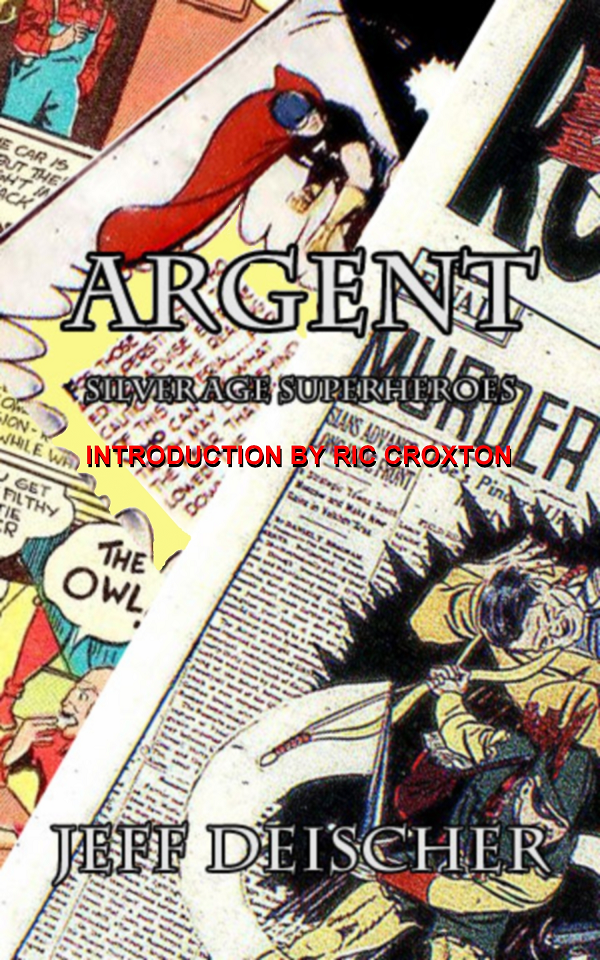Your love of golden age and public domain heroes seems apparent in your work. What drew you to those classic figures?
I actually don’t have a great love of “public domain characters” — superheroes, I mean. I have a great love for certain characters or groups of characters, and superheroes in general. The golden age superheroes I used in my The Golden Age series, I chose for specific practical reasons, not for any particular love of them. I do have a great affection of classical public domain characters. I think this is due to their fame in some cases, and otherwise because of my fondness for them from my childhood. This would include the Invisible Man and Frankenstein, for example, but not Captain Nemo or Sherlock Holmes, both of whom I discovered later, in my late teens. How can you read a series like John Carter (and love it) and not want to write a Carter novel? The stories and characters are so inspirational. The same is true of certain superheroes, public domain or not. What is there sparks ideas that were not used for these characters, unlike pantheons I create wholly from my own imagination. These obviously take more work to develop, although there’s greater satisfaction, I think, in those types of projects.
If it wasn’t love, what was your motivation for choosing the characters in The Golden Age?
Practicality. I felt there would be a built-in audience for public domain superheroes. The response to my first superhero book (The Overman Paradigm, written under the Kim Williamson pen name) was discouraging (though those who read it liked it, it didn’t sell many copies), so I wanted to give my next superhero book the best chance I could. That meant using characters that readers already knew. I chose Standard/Better/Nedor — not knowing that Alan Moore had done the same for his Terra Obscura — because there were so many characters to use. There was something like 22 in the first book in the series (also named The Golden Age), all the SBN characters who were superheroes, and a few who weren’t.
Your take on the characters is decidedly different than the one by Alan Moore, Chris Sprouse and Yanick Paquette. Did you ever read Terra Obscura after writing your novel to see how it compares? What did you think of it?
No. Once I learned of it while I was more than halfway through with writing The Golden Age, I glanced at a timeline of it I found online to make sure my ideas weren’t close to Moore’s, but I never read any of it.
What comics do you regularly read then? You said nothing too modern, but are there runs you love to read again and again?
I stopped collecting comics years ago. The last series I collected — I couldn’t tell you what it was — was 2007, probably, and there were only a handful of titles. Comic books went off the rails in the ’90s when it became about money and changing things for the sake of change rather than character and continuity. All I read these days are old comics. My favorites, the ones that I re-read over and over are Stan Lee and Steve Englehart comics. I re-read other comics sometimes, I have favorite series like Haywire, Marshall Law, and Watchmen (to name just three) that I go back to every so often, but when I’m in a comic mood, it’s usually Stan and Romita’s Spider-Man, Stan and Jack’s Fantastic Four, or Steve’s Captain America or The Avengers. Those are my standbys.
Haywire is an interesting pick. Not a lot of people know the series as it came and went in under two years at DC, an out of continuity (maybe) superhero book about a guy in a giant suit of armor with some questions about his actual identity. Can you give a brief rundown of the series and tell what draws you back to it after all these years?
I bought it new at the comics shop every month. The series is about a loser who has blackouts, and this giant armored being who fights the Combine (mob). It’s unclear for most of the series what’s going on. Who is the armored guy? Why is he fighting the mob? Why doesn’t he talk? Why is the loser the main character? Lots and lots of interesting questions. Okay, so SPOILER ALERT. It turns out that the main character is able to summon a sophisticated suit of armor, subconsciously, and become this unstoppable juggernaut. He doesn’t know that he’s able to do this. He has these blackouts — during which he’s the armored character, it turns out — that he goes to a therapist to find understanding. Eventually pieces start falling into place. I’ll resist revealing the loser’s actual identity and his motives for fighting the mob. The story would make a great movie if they could keep the tone of the series, and not Hollywoodize it. What I like about the series is the not “polished” superhero art, the intriguing characters, and the mystery of what’s going on. It was so well wrapped up that I didn’t realize it was supposed to be an ongoing series until much later. It seemed like a limited series to me.
We talk about a whole lot more, from role-playing to "pantsing" to the merits of DC's Millennium. Read it all over at Medium.


No comments:
Post a Comment